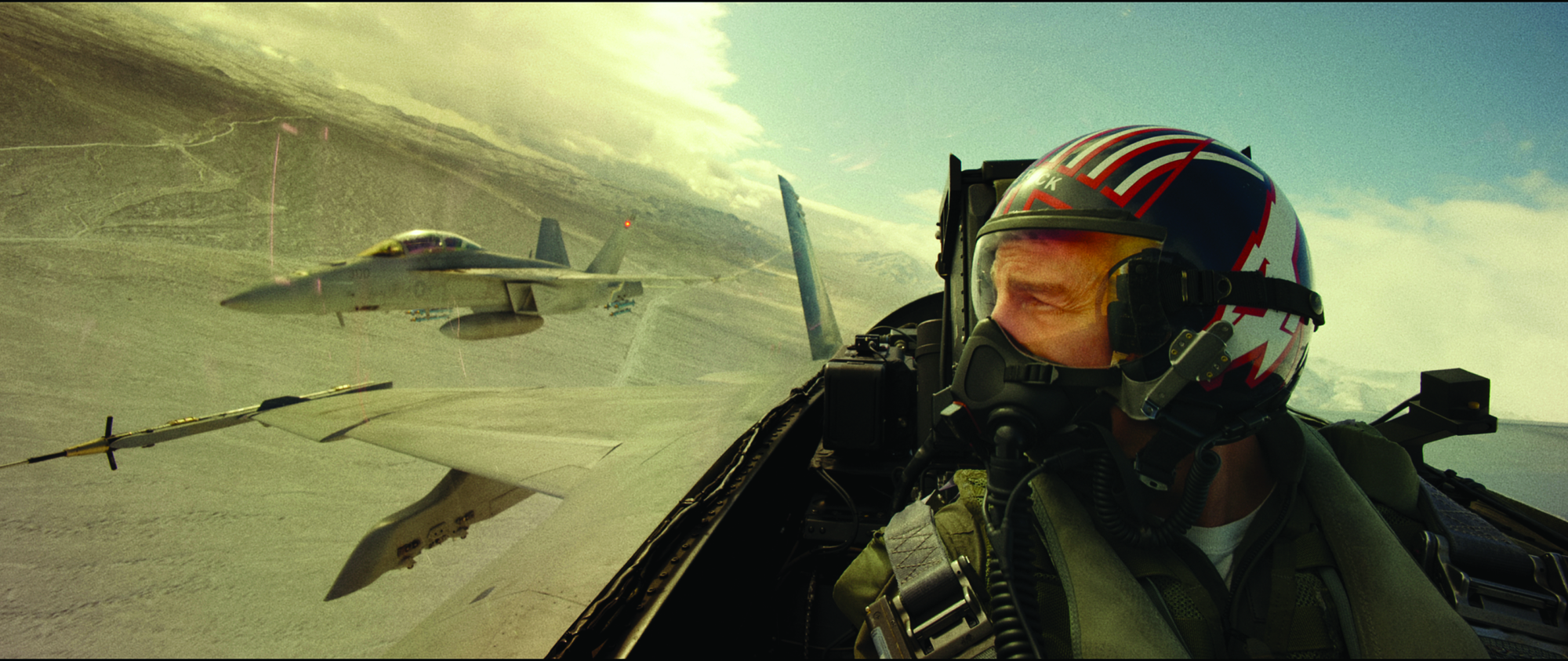The success of Top Gun: Maverick (Joseph Kosinski, 2022) was a surprise … for me, at least. Here was a long-delayed sequel – deferred not only by the intervening decades but also by the onset of COVID – to a film with a decidedly unserious pop-cultural footprint. Tony Scott’s 1986 original is remembered, sure, but largely for the cheese of Kenny Loggins’ ‘Danger Zone’ and the camp of its mid-film volleyball showdown.
Turns out the world was ready for more Top Gun.The 2022 follow-up, with Tom Cruise returning in the subtitular role, was one of the big success stories of post-COVID cinema – in box office terms, anyway. At the time of writing (and, six months on from its release, you’d better believe it was still screening), Top Gun: Maverick has earned almost US$1.5 billion internationally, placing it just outside the top ten – behind Furious 7 (James Wan, 2015) – in the worldwide all-time box office charts.[1]‘Top Lifetime Grosses’, Box Office Mojo, updated 24 October 2022, <https://www.boxofficemojo.com/chart/ww_top_lifetime_gross/>, accessed 25 October 2022. Australians are particularly enthused; in August, it became our nation’s third-highest-grossing film of all time.[2]‘Top Gun: Maverick Is Now the 3rd Highest-grossing Film in Aussie Box Office History’, Flicks.com.au, 1 August 2022, <https://www.flicks.com.au/news/top-gun-maverick-is-now-the-3rd-highest-grossing-film-in-aussie-box-office-history/>, accessed 25 October 2022.
Unlike many films featured in this column, Top Gun: Maverick’s storyline hews comparatively closely to reality, facilitating an understanding of speed, acceleration and aerodynamics.
All of the above means you can safely predict that a good chunk of a secondary school Science classroom will have seen the thing, which positions Top Gun: Maverick perfectly for this instalment of Cinema Science. And unlike many films featured in this column, the storyline hews comparatively closely to reality, facilitating an understanding of speed, acceleration and aerodynamics.

The need for speed
Beyond volleyball and Loggins, the other enduring reference from the original Top Gun is surely the oft-quoted line ‘I feel the need – the need for speed.’ Given this utterance is delivered by Cruise’s character, Pete ‘Maverick’ Mitchell, it shouldn’t come as a surprise that the film named after him is similarly impelled by velocity. Before a word of dialogue is spoken in Top Gun: Maverick, we see ‘mach 9’ (a measurement we’ll be exploring in more detail shortly) circled on the current day’s date on a calendar – and the subsequent need for speed proves integral to the film’s introduction and primary plotline.
Top Gun: Maverick’s introduction – the context for that circled figure – focuses on Maverick’s mission before the story proper: to become ‘the fastest man alive’. The pilot for experimental jet Darkstar, Maverick is tasked with reaching and ultimately exceeding mach 9. Despite his superior’s best wishes, he of course achieves this goal and then some, taking Darkstar to speeds exceeding mach 10 before the aircraft falls apart under the strain. Maverick, of course, ejects safely – from a storytelling perspective, the purpose here is to simultaneously demonstrate his reckless spirit and apparent invincibility – and the Darkstar program is largely forgotten. But just how realistic is this project … and what does mach 10 mean, anyway?

Well, here’s where we return from the lofty heights of Maverick’s mission to the solidity of the Science classroom. This is a great jumping-off point for two distinct, though interrelated, subjects: sound and speed. Speed, since the film illuminates an understanding of the different ways speed can be quantified – as vector (velocity) or scalar (speed), as a ratio of two units (for example, kilometres per hour or metres per second), or through other, more esoteric, measurements (like light years and mach) – and sound, because, well, that’s precisely how mach is defined.
In aerodynamics, an aircraft’s mach number measures ‘the ratio of the speed of the aircraft to the speed of sound in the gas’ it’s travelling through.[3]‘Mach Number’, National Aeronautics and Space Administration website, updated 13 May 2021, <https://www.grc.nasa.gov/www/k-12/airplane/mach.html>, accessed 25 October 2022. So mach 1 means the speed of sound in that medium, and an aircraft exceeding that speed is described as ‘supersonic’ (which is interesting enough for a lesson or two in its own right, particularly exploring sonic booms in the context of the Doppler effect[4]See ‘Doppler Effect’, National Aeronautics and Space Administration website, updated 13 May 2021, <https://www.grc.nasa.gov/www/k-12/airplane/doppler.html>, accessed 25 October 2022.). But we’re here to talk about hypersonic speeds and, to be precise, high hypersonic speeds, which is to say speeds greater than mach 5 and mach 10 respectively.
Is it realistic for a specifically designed aircraft like Darkstar to reach such speeds within the Earth’s atmosphere? Arguably, yes! Alhough the greatest speed achieved in analogous circumstances was well below this – back in 1976, the Lockheed SR–71 ‘Blackbird’ reached over 3500 kilometres per hour (around mach 3)[5]See Daniel Patrascu, ‘Top Gun: Maverick’s Mach 10 Darkstar Is a Sign of Military Aircraft to Come’, autoevolution, 26 June 2022, <https://www.autoevolution.com/news/top-gun-mavericks-mach-10-darkstar-is-a-sign-of-military-aircraft-to-come-192074.html>, accessed 2 January 2023. – the Darkstar and its capabilities are based on contemporary technology. US aerospace/defence corporation Lockheed Martin, which helped develop the fictional jet for the film, has stated the following:
Darkstar may not be real, but its capabilities are. Hypersonic technology, or the ability to travel at 60 miles per minute or faster, is a capability our team continues to advance today by leveraging more than 30 years of hypersonic investments and development and testing experience.[6]‘Top Gun – The Need for Speed’, Lockheed Martin website, <https://lockheedmartin.com/topgun>, accessed 16 October 2022.
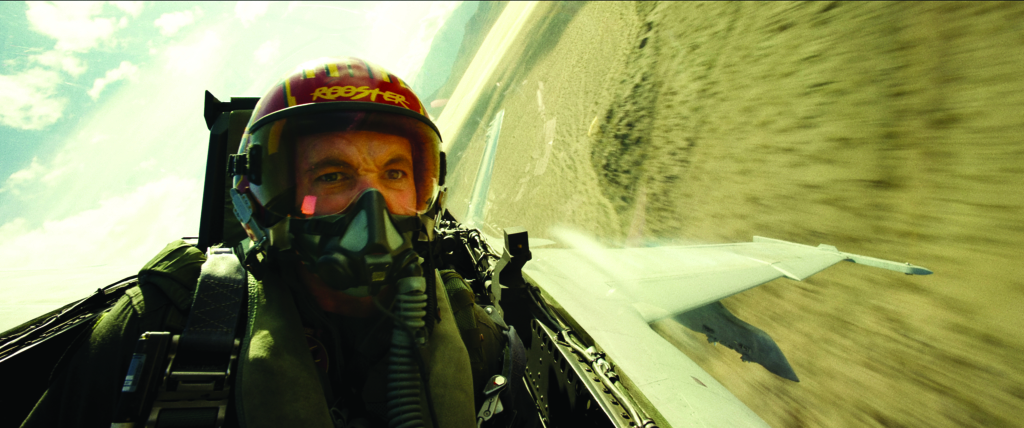
Granted, hypersonic speed isn’t quite the same as mach 10, but there’s real aerodynamic research underpinning Darkstar as represented in the movie – research that could form the basis for an extended exploration in the Science classroom. Even at the junior secondary level, there’s plenty to explore about the science of the speed of sound and ‘breaking the sound barrier’ without getting into high hypersonic speeds.
Alternatively, students could investigate Neil deGrasse Tyson’s assertion of the film’s lack of realism: ‘Maverick ejects from a hypersonic plane at Mach 10.5, before it crashed. He survived with no injuries. At that air speed, his body would splatter like a chainmail glove swatting a worm. Just sayin’.’[7]Neil deGrasse Tyson, Twitter post dated 10 October 2022, <https://twitter.com/neiltyson/status/1579165291434897409>, accessed 2 January 2023. Or maybe you could leave the nitpicking in Tyson’s experienced hands.
Strap yourself in and feel the gs
Speed isn’t integral to Top Gun: Maverick’s introduction alone. The bulk of the film’s storyline centres on Maverick training a crew of US Navy pilots to take on an apparent suicide mission. The pilots must complete a Star Wars–esque trench run – with an altitude of ‘100 feet maximum’ and an airspeed of ‘660 knots minimum’[8]For reference, 660 knots is just a shade below mach 1. – before rising to perform a perilous bombing run and finishing with a steep climb ‘pulling at least 8 gs.’
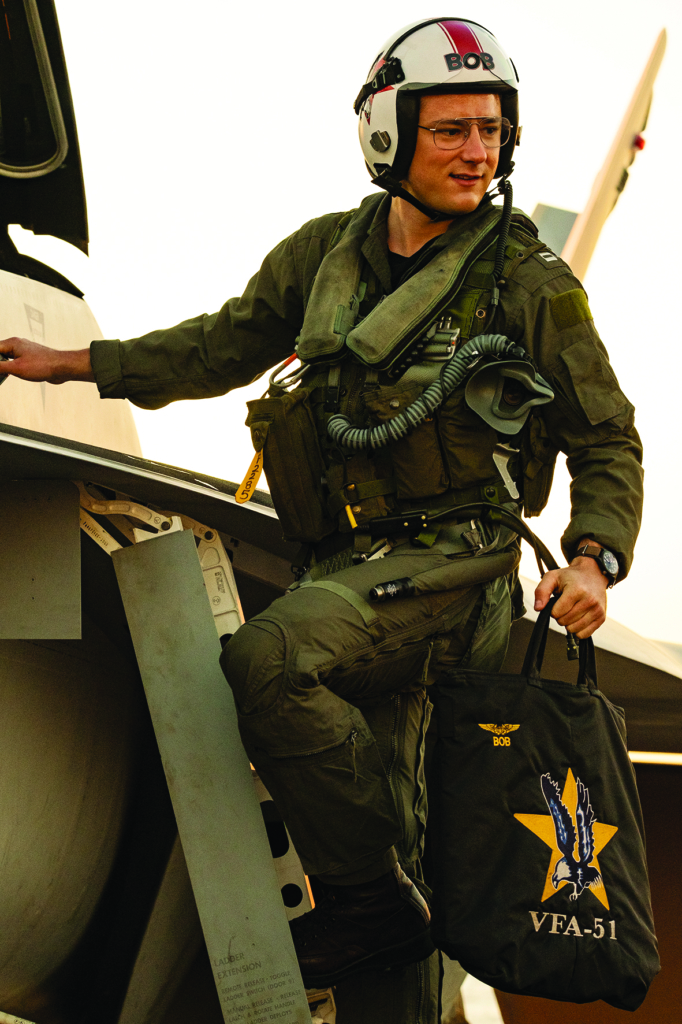
The seriousness of this is emphasised by the character chosen to deliver the line: Jake ‘Hangman’ Seresin (Glen Powell), a naval aviator whose defining, usually unshakeable, arrogance falters here. It’s further reinforced by the film’s publicity materials, which highlight Kosinski’s choice to apply ‘up to 1,600 lbs. of force, or 8 [gs], in some of the stunts’ and the challenge that presented for the actors.[9]Anna Lazarus Caplan, ‘Tom Cruise and Top Gun: Maverick Cast Describe Film’s “Grueling” and “Intense” G-force Stunts’, People,22 August 2022, <https://people.com/movies/tom-cruise-top-gun-maverick-cast-describe-intense-stunts-exclusive/>, accessed 25 October 2022. Miles Teller, who plays Bradley ‘Rooster’ Bradshaw in the film, is quoted as saying, ‘There’s not too much acting going on. You’re just trying to not pass out, not puke.’[10]Miles Teller, quoted in Caplan, ibid. Or as Maverick puts it in the film itself:
You’ll be pulling so hard you’ll weigh close to 2000 pounds, your skull crushing your skin, your lungs imploding like an elephant’s sitting on your chest, fighting with everything you have just to keep from blacking out.
Clearly ‘8 gs’ is a big deal, then. But what is g-force in this context? To answer that question unwraps a whole world of investigating the classical physics associated with acceleration in the classroom. Much like the mach measurement of speed, gs are measured in reference to a constant – specifically, acceleration due to gravity (roughly 9.8 metres per second per second on the Earth’s surface). So eight gs is acceleration eight times the magnitude of what would typically be experienced on the surface, meaning that the actors[11]As well as the pilots they’re playing in the fiction of the movie, if you want to present it that way. I tend to think that acknowledging the physical reality of the stunt would be more engaging for students, but your mileage may vary. would feel eight times heavier than usual during these stunts.
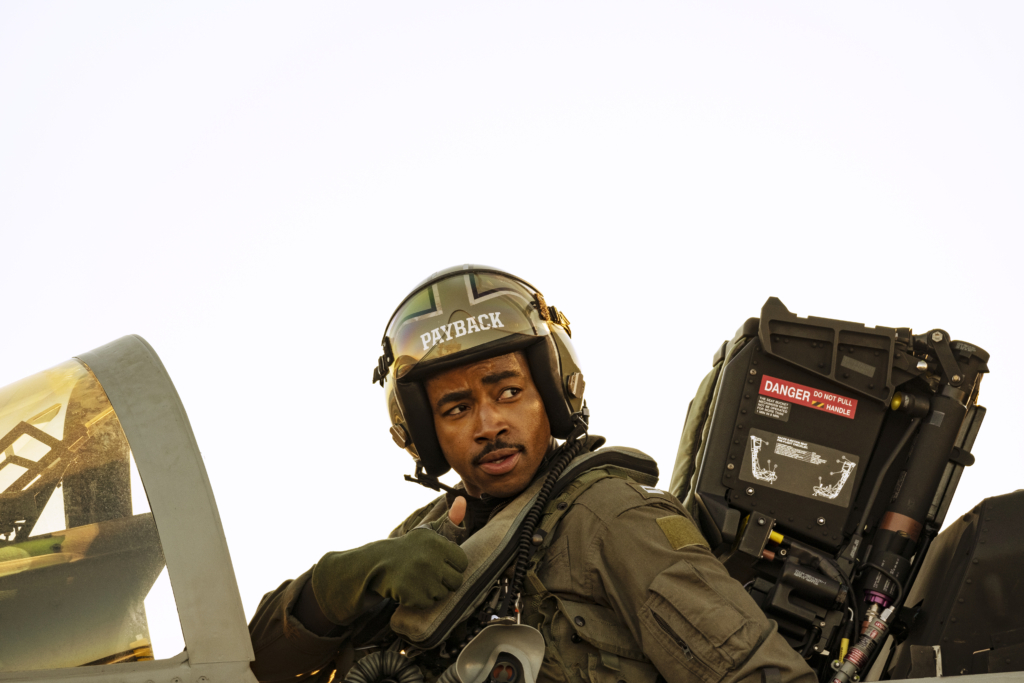
This last point requires some unpacking, and is where I’d start the conversation for budding young scientists. Secondary students with some physics familiarity should already understand the basics of projectile motion: that a falling object (absent air resistance) will get faster and faster as it falls thanks to the gravitational pull of the Earth. But the connection between that knowledge and the experience of acceleration – say, the way the g-force in Top Gun: Maverick distorts its actors’ faces, or causes a pilot to go into ‘g-LOC’[12]G-force-induced loss of consciousness, which in the film affects Javy ‘Coyote’ Machado (Greg Tarzan Davis) during a training exercise. – is less immediately apparent.
Secondary students with some physics familiarity should already understand the basics of projectile motion … But the connection between that knowledge and the experience of acceleration is less immediately apparent.
While I won’t go into an explanation of the phenomenon myself here, the film and its stunts present a prime vantage point through which to examine the connection between acceleration, force and the associated experience. Someone experiencing freefall will feel momentarily weightless because of the lack of a normal reaction force (that is, the ground is no longer resisting the pull of gravity), whereas someone standing on a solid surface will be experiencing 1 g due to the normal force from the ground. On the other hand, planes undergoing rapid acceleration – whether due to turning sharply, rising steeply or simply increasing in speed – apply a much stronger g-force to their pilots, as witnessed in the film.
Students can experience this for themselves: not by jumping into a fighter jet, of course, but by sitting in a car as it accelerates, standing in an elevator as it moves between levels or (in a common Physics excursion) riding on a roller-coaster. By exploring such experiences, students will not only appreciate the connection between potentially abstract scientific concepts but also understand the limitations of our anatomy in the context of extreme acceleration. You can also explore the engineering limits of the navy’s planes, described as having a ‘stress limit’ of 7.5 gs in the film – which leads us neatly into our last topic.
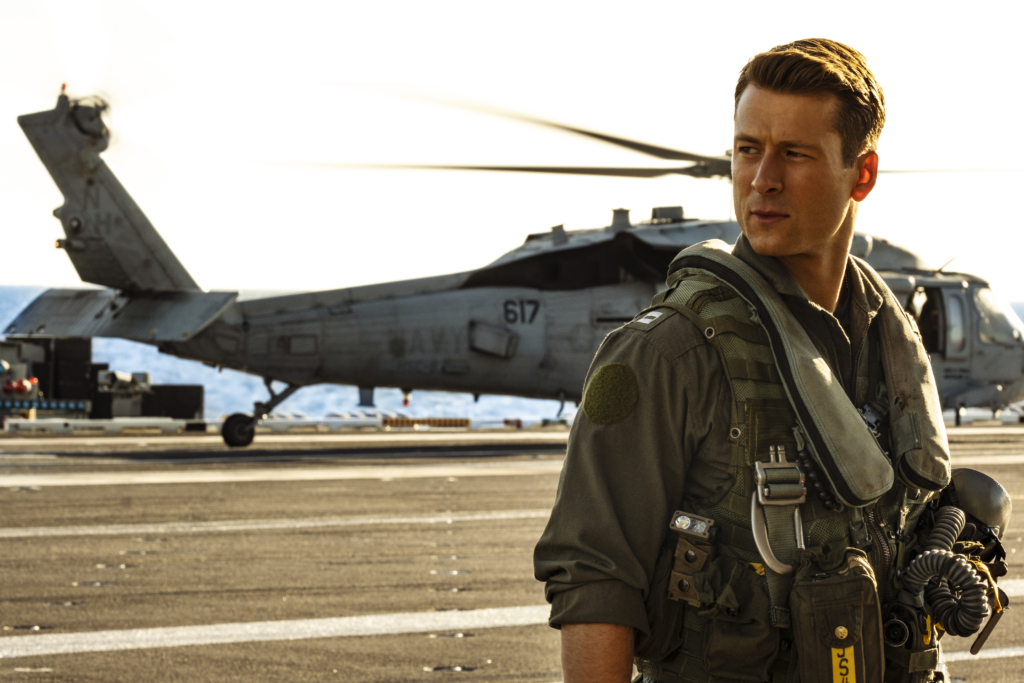
Aeronautical Technology
The main narrative of Top Gun: Maverick hinges on a couple of conceits. The first is that the US is no longer in possession of the highest-tech fighter planes in the world, with the latest-generation fighters presenting a fearsome threat. (I can’t speak to the realism of this, but given the film’s choice to conceal the identity of the antagonist nation building a uranium enrichment plant, it’s easy enough to accept this aspect of the premise.)
The second conceit feels more artificial. To prevent the navy from relying on drones – automated aircraft that could obviate the need for pilots vulnerable to the aforementioned g-forces – the screenplay equips the unnamed enemy with a suite of GPS jammers that are an unavoidable antidote to automation. Hence, the need for the human element that a film like this requires.
From a storytelling perspective, you’re not supposed to dwell on these workarounds; they’re in the same ballpark as mobile phones losing coverage or running out of batteries in any modern horror movie. But this opens another window for nascent scientists looking to understand contemporary aeronautics. After all, while teachers aren’t exactly trying to walk students into the military technology industry, it’s important to accommodate the students whose interest in the discipline will be realised in engineering or similar fields.

Top Gun: Maverick, then, allows students to research, with teacher assistance, the aerodynamic challenges facing new-generation aircraft and drone technology – though perhaps in the commercial rather than military sphere. Students can begin with designing and refining their own paper planes,[13]See Dave Crewe, ‘Cinema Science: Aerodynamic Instruction and Paper Planes’, Metro, no. 208, 2021, pp. 86–91, available at <https://metromagazine.com.au/cinema-science-208/>, accessed 2 January 2023. before investigating the design of consumer drones and how these principles extend to their larger equivalents.
Though I’d personally steer away from military drones, the scientific and social potential of drones – recreation, photography, delivery – is immense, and already being realised across the world. Understanding the aerodynamic principles associated with their design is one thing, but this exploration also allows for a foray into the science of wireless communication, effective engines and the coding required to operate these drones safely. You could also explore the realism of the GPS jammers alluded to in Top Gun: Maverick’s screenplay, and whether such devices would be feasible in this context; though that might be spreading our wings a touch too wide – much as Maverick would approve.
Endnotes
| 1 | ‘Top Lifetime Grosses’, Box Office Mojo, updated 24 October 2022, <https://www.boxofficemojo.com/chart/ww_top_lifetime_gross/>, accessed 25 October 2022. |
|---|---|
| 2 | ‘Top Gun: Maverick Is Now the 3rd Highest-grossing Film in Aussie Box Office History’, Flicks.com.au, 1 August 2022, <https://www.flicks.com.au/news/top-gun-maverick-is-now-the-3rd-highest-grossing-film-in-aussie-box-office-history/>, accessed 25 October 2022. |
| 3 | ‘Mach Number’, National Aeronautics and Space Administration website, updated 13 May 2021, <https://www.grc.nasa.gov/www/k-12/airplane/mach.html>, accessed 25 October 2022. |
| 4 | See ‘Doppler Effect’, National Aeronautics and Space Administration website, updated 13 May 2021, <https://www.grc.nasa.gov/www/k-12/airplane/doppler.html>, accessed 25 October 2022. |
| 5 | See Daniel Patrascu, ‘Top Gun: Maverick’s Mach 10 Darkstar Is a Sign of Military Aircraft to Come’, autoevolution, 26 June 2022, <https://www.autoevolution.com/news/top-gun-mavericks-mach-10-darkstar-is-a-sign-of-military-aircraft-to-come-192074.html>, accessed 2 January 2023. |
| 6 | ‘Top Gun – The Need for Speed’, Lockheed Martin website, <https://lockheedmartin.com/topgun>, accessed 16 October 2022. |
| 7 | Neil deGrasse Tyson, Twitter post dated 10 October 2022, <https://twitter.com/neiltyson/status/1579165291434897409>, accessed 2 January 2023. |
| 8 | For reference, 660 knots is just a shade below mach 1. |
| 9 | Anna Lazarus Caplan, ‘Tom Cruise and Top Gun: Maverick Cast Describe Film’s “Grueling” and “Intense” G-force Stunts’, People,22 August 2022, <https://people.com/movies/tom-cruise-top-gun-maverick-cast-describe-intense-stunts-exclusive/>, accessed 25 October 2022. |
| 10 | Miles Teller, quoted in Caplan, ibid. |
| 11 | As well as the pilots they’re playing in the fiction of the movie, if you want to present it that way. I tend to think that acknowledging the physical reality of the stunt would be more engaging for students, but your mileage may vary. |
| 12 | G-force-induced loss of consciousness, which in the film affects Javy ‘Coyote’ Machado (Greg Tarzan Davis) during a training exercise. |
| 13 | See Dave Crewe, ‘Cinema Science: Aerodynamic Instruction and Paper Planes’, Metro, no. 208, 2021, pp. 86–91, available at <https://metromagazine.com.au/cinema-science-208/>, accessed 2 January 2023. |
